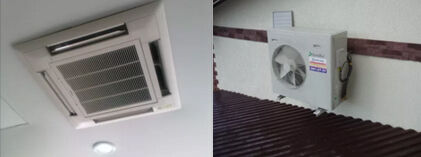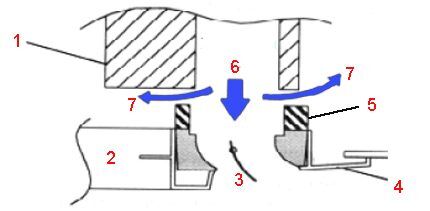Cassette split system: design features, pros and cons of equipment + installation nuances
The cassette split system, from a technological point of view, is not much different from the classic air conditioner design.The only obvious difference from the classics is that the cassette split system uses an internal module that is not wall-mounted, but sub-ceiling.
Everything else is an actual analogy of the classics, including the principle of operation, the pros and cons of the design, and the features of installation work. In this article, we will consider in detail all the features of cassette configuration systems, including the device, operating principle, its advantages and disadvantages, as well as the subtleties of equipment installation.
The content of the article:
Device of a household cassette air conditioner
Cassette-type cooling technology is a two-module system, thanks to which the function of cooling the air to a given temperature is carried out.
The cassette split system set consists of the following modules:
- External (street).
- Interior (apartment, office).
Both modules of the kit are individual blocks, which, when the system is installed in working condition, are combined with process pipelines and electrical connections.

It should be noted: cassette-type split systems are more often used as office equipment, installed at small business sites and inside administrative buildings.
Application in apartments or houses is quite rare. The main reason for this situation is the need to install a false ceiling at the site, because the indoor module is intended to be mounted under the ceiling.
Structure of the external module
This part of the cassette air conditioner design fully corresponds to the classic design of household air conditioning systems.
The block street module contains the following components inside:
- compressor;
- capacitor;
- fan;
- automation elements;
- electrical parts.
The compressor and condenser are united by a refrigeration circuit charged with freon, from which contact points are made through a pair of linear shut-off valves for connection to the indoor unit.

Electrical connections for automatic control and power supply of the compressor of the external module are also output to the contact panel of the internal module, where they are switched accordingly (according to the diagram) and are connected to the general power supply.
Features of the indoor unit
This part of the air conditioner is made in the form of a working block cassette with a panel designed for installation in the ceiling structure. Moreover, the ceiling structure must have a so-called false ceiling.
The working (system) unit is “hidden” under the false covering, and the distribution panel remains on the same plane with the false covering.

The distribution panel of the internal cassette unit generally contains several elements:
- Air intake grille.
- Coarse filter.
- Ionizer filter.
- Rigid frame.
- Faceplate.
- Distribution blinds.
The air intake grille with ionization and coarse filters and a rigid frame is located in the central area of the distribution panel.
Along the perimeter - on the sides of the same distribution panel - there are cooled air outlet channels, complemented by blinds with automatic cyclic flow regulation.

The front cover of the cassette distribution panel, among other things, contains a light indication and remote control board. There is a model version equipped with a wired control panel.
The working cassette unit, “hidden” under the false ceiling, is part of the refrigeration structure, which includes: an evaporator, a fan, a condensate drainage device, connection points for lines from the outdoor module, and an electrical connection board.
How does the cassette system work?
Actually, the principle of operation of the classic air conditioning system does not change here. The refrigerant used is also one of those brands that are most often used in practice. That is, for example, R410A refrigerant and similar refrigerants.

This substance is used to refill the system circuit provided that the cassette installation, which combines the external and internal modules, is fully assembled. We recommend that you familiarize yourself with the intricacies of independent refilling the system with freon.
After the cassette split system is put into operation, the refrigerant circulates inside the circuit due to the operation of the compressor. Its circulation leads to cooling of the evaporator.
Through the evaporator located in the cassette housing of the internal module, the fan draws air, which is sucked through the air intake grille. Cooled by the evaporator, the air is supplied to the outlet into side channels equipped with louvers.

The design of the side channels has a characteristic design - the outgoing part is bent by approximately 30-35 degrees. Therefore, the cooled air flow emanating from the cassette channels is directed not vertically downward, but to the sides.
Given the presence of duct outlets on all four sides of the distribution panel, the air flow is distributed evenly in four directions.
Advantages and disadvantages of equipment
Cassette climate control technology, like the classic one, has its pros and cons. Which we will consider in more detail below.
The main advantages of cassette models
A clear advantage of cassette split systems is the uniformity of air flow distribution over the room area.
Moreover, this advantageous factor is directly related to the installation requirements, according to which the installation of the ceiling cassette is provided exclusively in the central part of the room.
Thanks to the optimal placement of the cassette and the same optimal air distribution, it is possible to more effectively cool the rooms to the required temperature.
Another advantage is the architectural component. If classic split systems, which use wall-mounted internal modules, create real problems in terms of design organization, it is easier with cassette modules.

Moreover, cassettes built into the ceiling often become design elements that enhance the overall attractiveness. This is especially noted in the design of office and administrative premises.
Obvious disadvantages of technology
Cassette split systems also have some serious disadvantages. One of these pronounced shortcomings seems to be installation limitations. In particular, it is possible to install equipment only in places with a suspended ceiling.
However, not every suspended ceiling design can satisfy installation requirements, since a certain gap is required between the real and false ceiling.

A disadvantage of such systems may also be poor-quality insulation between the bottom side of the cassette body and the distribution panel (figure above).In this case, cooled air penetrates into the ceiling space and condenses.
As a result, there is a leakage effect and, as a consequence, destruction of part of the suspended ceiling structure. However, this drawback can be eliminated technically - through high-quality insulation.
Features of installing a cassette air conditioner
If we consider the external module of a cassette split system, there are no features that distinguish the installation from the classic standard.
The internal cassette module is a completely different matter. In this case, the installation-related features are determined by the design of the block.
Main features of cassette module installation:
- the surface for installing the cassette is strictly horizontal;
- the gap between the open and false ceiling is at least 350 mm;
- the ceiling structure must withstand 4 times the weight of the cassette;
- The installation position corresponds to the required distances from obstacles.
When installing the system, you should take into account the location of doorways, heating elements, and various heat sources.
Also, the installation position should be coordinated according to the power supply points, the possibilities of supplying loop pipelines and the condensate drainage channel.

The cassette must be mounted in such a way as to exclude the presence of objects that impede the uniform distribution of air.
As a rule, it is necessary to install the cassette module as close as possible to the central point of the room. Installation is performed with the distribution panel and other components included in the panel assembly removed.
The cassette module is installed using the hanging method. Therefore, suspended metal rods have to be installed on the main ceiling.
Holes for four anchor rods are drilled on the surface of the main ceiling. The size (standard) between the rods is pre-marked in width and length.

The cassette module is suspended from the installed rods, leveled horizontally and secured. Accordingly, it is necessary to divert the drainage line according to all the rules - at a slope, without sharp bends. And also connect the refrigeration circuit pipes.
Only after this work has been completed, the surrounding part of the false ceiling is assembled and the parts of the distribution panel of the split system cassette are installed.
In addition to cassette, there are other types of ceiling air conditioning systems. To get acquainted with them in more detail, please go to the following link.
Conclusions and useful video on the topic
A video about cassette systems - simple, clear and without unnecessary words about the structure of the equipment and operational capabilities. All the main things a potential owner needs to know:
Cassette-type split systems are quite interesting equipment due to their inherent design features and technical characteristics.
However, it is often not possible to install and operate cassette systems at home, especially in apartments. Another question is offices, administrative premises, business buildings.For such an architecture, the equipment can be characterized as the most optimal.
Are you thinking about buying a cassette-type split system, but want to clarify some features that we did not touch upon in this material? Ask your questions to our experts - we will try to help you.
If you notice a discrepancy in the material or want to supplement our publication with useful information, please write your comments in the block below.




We need a condenser for a room that will be used as a cafe. I want to get more or less uniform cooling of the entire room. Is it better to take a cassette or a wall-mounted one?